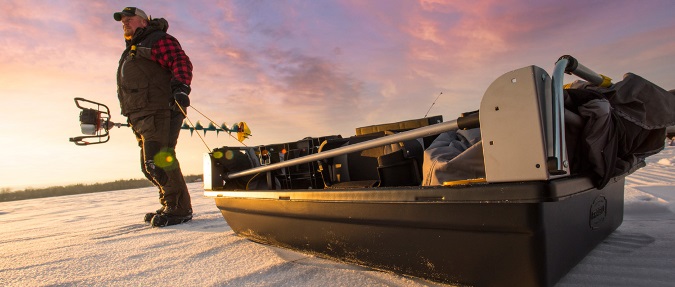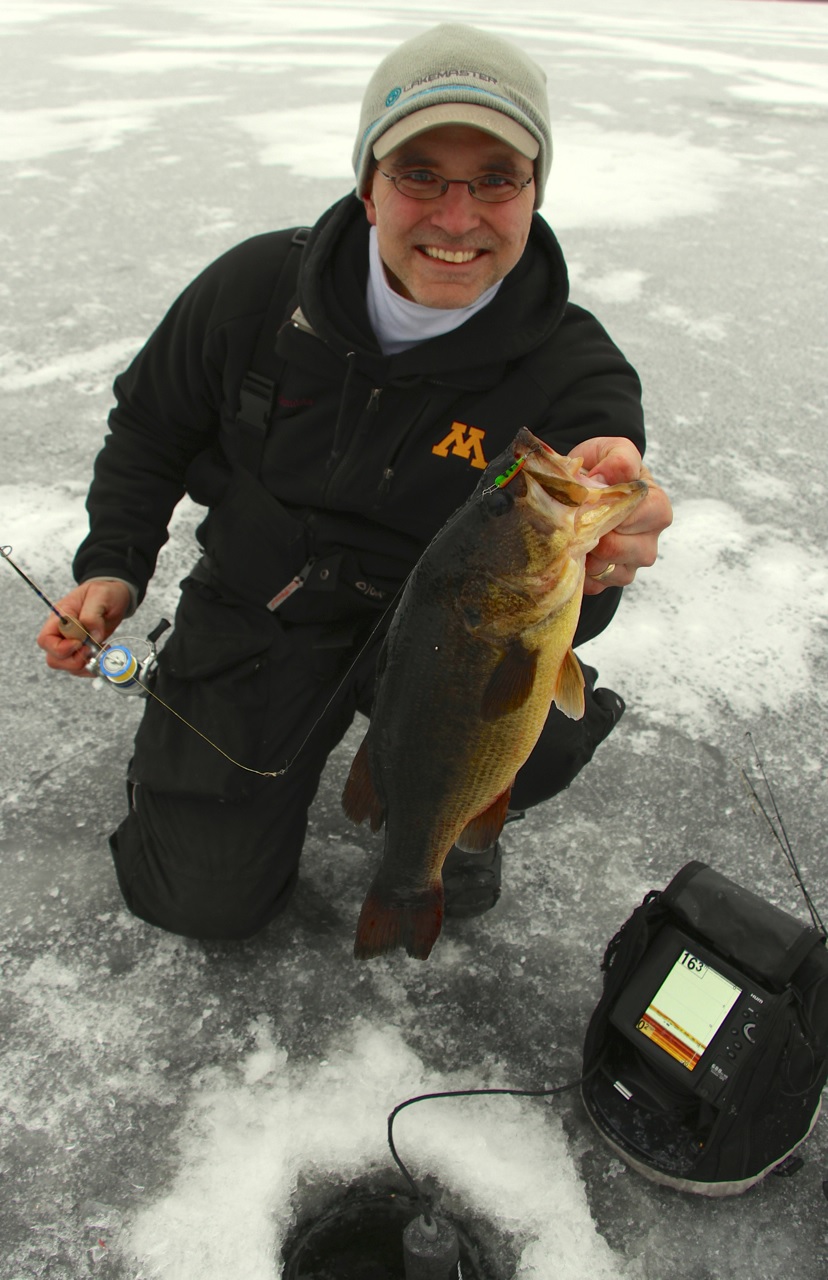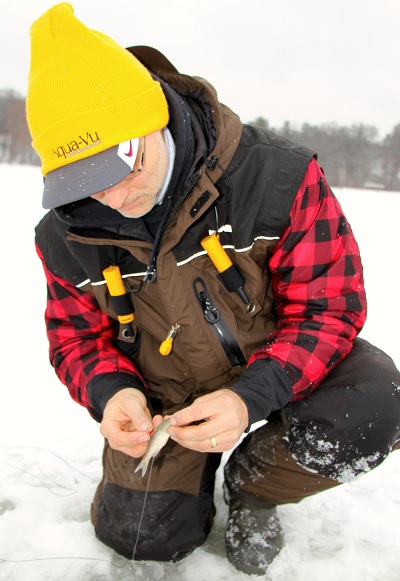Anglers await the arrival of the first ice of winter with great anticipation. The short-lived first ice bite is classically one of the best of the winter, with active fish still found in near-shore, oxygen-rich waters that are easily accessible to the walk-on angler. My early season ice fishing adventures are governed by three guiding principles: stay safe, travel light, and fish shallow. Read on to learn about the tools that I use to accomplish these goals, AND return home with a pail of fish.

Stay Safe
Early season hard-water adventures often occur on frozen lakes that are capped by a relatively thin layer of ice. I heed the well-publicized guidelines distributed by my regional Natural Resources managers, which generally indicate that 4-inches of hard, black ice are suitable for foot travel. On frozen lakes that have not been previously accessed by other early season anglers, I will check ice thickness along my walking path using a spud bar, which is, in essence, a long-handled ice chisel. If I measure less than 4 inches of ice thickness, I will turn back toward shore.
Even with general ice coverage of 4-inches or more, thin spots may persist in the early season due to springs, current, or even the action of schools of fish or flocks of waterfowl. It is important to have a plan to get back onto the ice surface, should you fall unexpectedly through the ice. My Frabill I3 Jacket includes an integrated Self-Rescue device over the shoulders, ensuring that the ice picks are easily accessible should I fall through a thin spot. Integrated drainage mesh in my Frabill I3 suit also allows any water that accumulates in the suit to drain rapidly away.
Creepers, or some other sort of traction-enhancing device for your feet, are also useful tools for the early season ice angler. The first ice of the season is often free of snow cover, quite flat, and extremely slippery. Falls on the ice can lead to bumps, bruises, sprains, or worse, and increasing the traction of your footwear can help to minimize these injuries.
Be conservative when venturing onto early season ice. No fish is worth your life. Those fish will remain in the same general areas for a couple of weeks, so don’t rush prematurely onto an unsafe crust of ice; wait until conditions permit you to enjoy the first ice period while staying safe and dry.
 Travel Light
Travel Light
First ice is NOT the time to haul your snow machine or hard-sided ice house to the lake. You will be traveling on foot, and you don’t want to be weighed down pulling hundreds of pounds of gear in pursuit of a hot early-ice bite. I limit my load to those items that I can fit comfortably into a medium sized sled. If it doesn’t fit, it stays in the truck. Here are the key items that always make the cut.
I bring two pieces of ice electronics with me on every ice adventure; one of these is a Humminbird sonar/GPS combo, like the HELIX 5 ICE or ICE 688ci HD Combo. These multi-functional pieces of electronics allow me to walk to the fishing grounds with GPS precision, and target the fish lingering there with either a traditional flasher-wheel sonar display or an “open water” view that is rich in historical sonar information. The second piece of must-have ice electronics is my Aqua-Vu Micro 5 camera. This compact underwater viewing device fits perfectly in the front pocket of my Frabill I3 bibs, and features a long-life Lithium Ion battery that provides for many hours of continuous use. I use my underwater camera to identify the fish I observe on my sonar, find green weeds along expansive weed edges, and even monitor baits suspended under tip-ups to learn how fish are reacting to them.
I pack a lightweight, portable shelter on early ice trips. This can take the form of a one-angler flip-over, like the Frabill Recruit 1250, which also provides the sled that I use to transport all of my gear. Unique design features of the Recruit 1250 provide me with more fishable area than other one-angler flip-over shelters, and also incorporates a full thermal shell to ensure a warm, comfortable day on early ice. If I’m fishing with a friend, I trade my flip-over for a thermal hub, like the Frabill Bro Hub which provides plenty of room for two anglers plus all of their gear, and an expansive 80” of headroom to allow for a good stand-up-and-stretch when the bite slows. Weighing in at just 36 pounds, the Bro Hub is easy to transport to and from the fishing grounds.
Beyond my electronics and shelter, everything else that I carry, including rods in a hard case to keep them safe and secure, essential tackle and tools, tip-ups when chasing fish with teeth, an assortment of live bait, and snacks and drinks, all need to fit into that single sled. If you minimize the amount of gear you bring on early ice trips, you’ll be more likely to remain mobile on the ice, and mobility is the key to success for the modern ice angler.
 Fish Shallow
Fish Shallow
The early ice period features one of the best near-shore, shallow water bites of the ice season. Those waters remain well oxygenated from fall winds and rains, and any shallow cover like weeds, rocks or timber will rapidly accumulate baitfish populations, as well as the gamefish and panfish that feast upon them. Now is the time to target those fish, before they vacate the shallows and head to the primary breaklines or the deep basin.
Shallow fish are generally more active, and respond more favorably to aggressive presentations, than their deep water cousins. Now is not the time for micro baits rigged on the tiniest tungsten jig that money can buy. I favor larger profile, high-action baits like the soft-plastic Ratso or the Slender Spoon from Custom Jigs and Spins. There is generally no need to tip the Ratso with any sort of live bait, as the supple action of the long Ratso tail is all that an angler needs to trigger bites. Likewise, if you plan to accessorize the Slender Spoon with an organic bait, limit that to only a minnow head, as an entire minnow will deaden the tantalizing flutter of the often imitated, but never duplicated, Slender Spoon. When you’re fishing the Slender Spoon under low light conditions, be sure to tie on a Pro-Glow Slender Spoon, and supercharge that spoon with a small LED light to enhance the bait’s appeal to crappies or walleyes lurking beneath the lake’s frozen cap.
Yes, I know there are crappies suspended out over the basin. And yes, I recognize there are probably some walleyes on that mid-lake rockpile. However, I hate to walk past catchable fish to find other fish that are much farther away, so I plan to take advantage of this early ice, shallow water bite for as long as it lasts. We’ll have plenty of opportunities to retool for offshore adventures as the winter progresses.
About the author
Dr. Jason Halfen owns and operates The Technological Angler, with a primary mission of informing and training anglers on the use of modern technological tools to find and catch more fish. Learn about The Technological Angler’s award winning instructional videos, teaching tools, and angler training workshops at http://www.technologicalangler.com.
Dr. Jason Halfen
